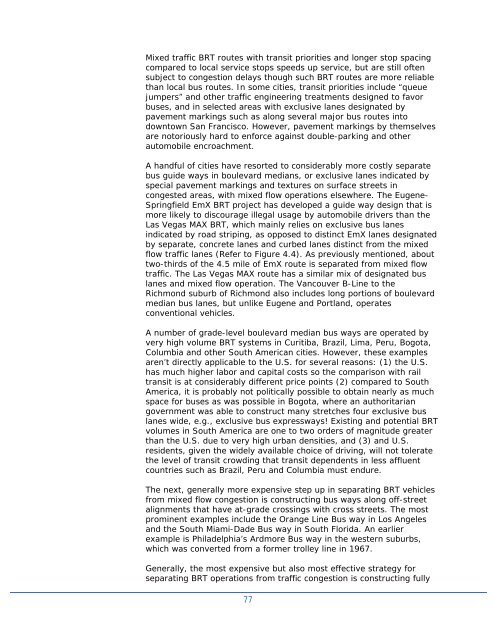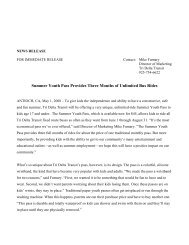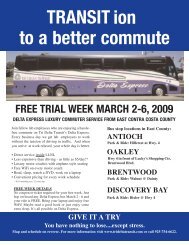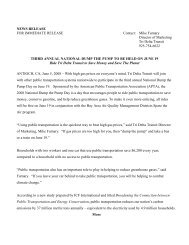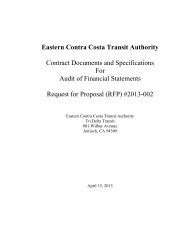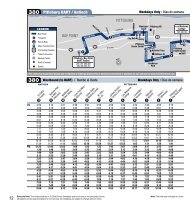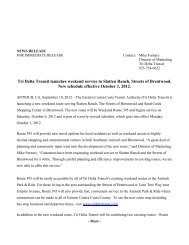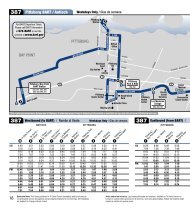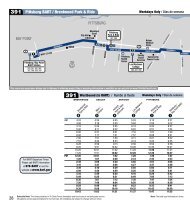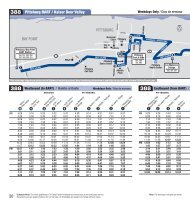to view Short Range Transit Plan FY 2007/2008 - Tri Delta Transit
to view Short Range Transit Plan FY 2007/2008 - Tri Delta Transit
to view Short Range Transit Plan FY 2007/2008 - Tri Delta Transit
Create successful ePaper yourself
Turn your PDF publications into a flip-book with our unique Google optimized e-Paper software.
Mixed traffic BRT routes with transit priorities and longer s<strong>to</strong>p spacingcompared <strong>to</strong> local service s<strong>to</strong>ps speeds up service, but are still oftensubject <strong>to</strong> congestion delays though such BRT routes are more reliablethan local bus routes. In some cities, transit priorities include “queuejumpers” and other traffic engineering treatments designed <strong>to</strong> favorbuses, and in selected areas with exclusive lanes designated bypavement markings such as along several major bus routes in<strong>to</strong>down<strong>to</strong>wn San Francisco. However, pavement markings by themselvesare no<strong>to</strong>riously hard <strong>to</strong> enforce against double-parking and otherau<strong>to</strong>mobile encroachment.A handful of cities have resorted <strong>to</strong> considerably more costly separatebus guide ways in boulevard medians, or exclusive lanes indicated byspecial pavement markings and textures on surface streets incongested areas, with mixed flow operations elsewhere. The Eugene-Springfield EmX BRT project has developed a guide way design that ismore likely <strong>to</strong> discourage illegal usage by au<strong>to</strong>mobile drivers than theLas Vegas MAX BRT, which mainly relies on exclusive bus lanesindicated by road striping, as opposed <strong>to</strong> distinct EmX lanes designatedby separate, concrete lanes and curbed lanes distinct from the mixedflow traffic lanes (Refer <strong>to</strong> Figure 4.4). As previously mentioned, abouttwo-thirds of the 4.5 mile of EmX route is separated from mixed flowtraffic. The Las Vegas MAX route has a similar mix of designated buslanes and mixed flow operation. The Vancouver B-Line <strong>to</strong> theRichmond suburb of Richmond also includes long portions of boulevardmedian bus lanes, but unlike Eugene and Portland, operatesconventional vehicles.A number of grade-level boulevard median bus ways are operated byvery high volume BRT systems in Curitiba, Brazil, Lima, Peru, Bogota,Columbia and other South American cities. However, these examplesaren’t directly applicable <strong>to</strong> the U.S. for several reasons: (1) the U.S.has much higher labor and capital costs so the comparison with railtransit is at considerably different price points (2) compared <strong>to</strong> SouthAmerica, it is probably not politically possible <strong>to</strong> obtain nearly as muchspace for buses as was possible in Bogota, where an authoritariangovernment was able <strong>to</strong> construct many stretches four exclusive buslanes wide, e.g., exclusive bus expressways! Existing and potential BRTvolumes in South America are one <strong>to</strong> two orders of magnitude greaterthan the U.S. due <strong>to</strong> very high urban densities, and (3) and U.S.residents, given the widely available choice of driving, will not <strong>to</strong>leratethe level of transit crowding that transit dependents in less affluentcountries such as Brazil, Peru and Columbia must endure.The next, generally more expensive step up in separating BRT vehiclesfrom mixed flow congestion is constructing bus ways along off-streetalignments that have at-grade crossings with cross streets. The mostprominent examples include the Orange Line Bus way in Los Angelesand the South Miami-Dade Bus way in South Florida. An earlierexample is Philadelphia’s Ardmore Bus way in the western suburbs,which was converted from a former trolley line in 1967.Generally, the most expensive but also most effective strategy forseparating BRT operations from traffic congestion is constructing fully77


